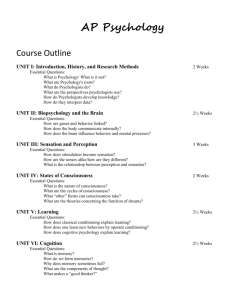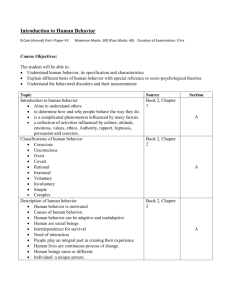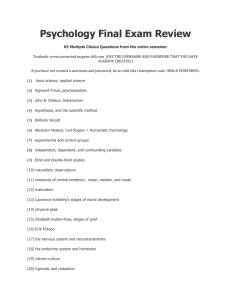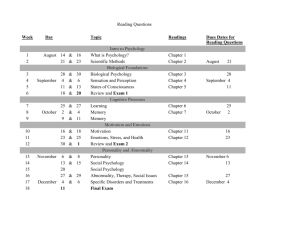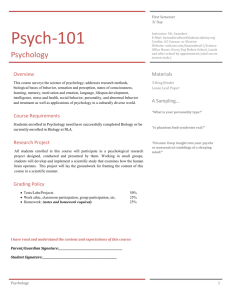AP Psychology
advertisement
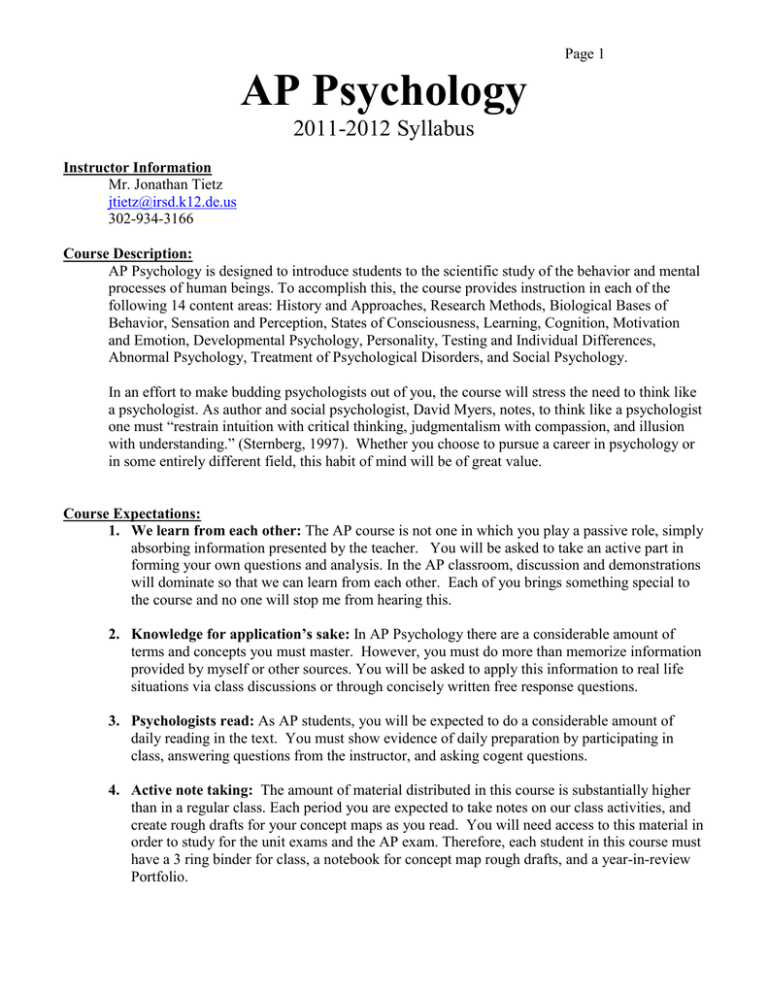
Page 1 AP Psychology 2011-2012 Syllabus Instructor Information Mr. Jonathan Tietz jtietz@irsd.k12.de.us 302-934-3166 Course Description: AP Psychology is designed to introduce students to the scientific study of the behavior and mental processes of human beings. To accomplish this, the course provides instruction in each of the following 14 content areas: History and Approaches, Research Methods, Biological Bases of Behavior, Sensation and Perception, States of Consciousness, Learning, Cognition, Motivation and Emotion, Developmental Psychology, Personality, Testing and Individual Differences, Abnormal Psychology, Treatment of Psychological Disorders, and Social Psychology. In an effort to make budding psychologists out of you, the course will stress the need to think like a psychologist. As author and social psychologist, David Myers, notes, to think like a psychologist one must “restrain intuition with critical thinking, judgmentalism with compassion, and illusion with understanding.” (Sternberg, 1997). Whether you choose to pursue a career in psychology or in some entirely different field, this habit of mind will be of great value. Course Expectations: 1. We learn from each other: The AP course is not one in which you play a passive role, simply absorbing information presented by the teacher. You will be asked to take an active part in forming your own questions and analysis. In the AP classroom, discussion and demonstrations will dominate so that we can learn from each other. Each of you brings something special to the course and no one will stop me from hearing this. 2. Knowledge for application’s sake: In AP Psychology there are a considerable amount of terms and concepts you must master. However, you must do more than memorize information provided by myself or other sources. You will be asked to apply this information to real life situations via class discussions or through concisely written free response questions. 3. Psychologists read: As AP students, you will be expected to do a considerable amount of daily reading in the text. You must show evidence of daily preparation by participating in class, answering questions from the instructor, and asking cogent questions. 4. Active note taking: The amount of material distributed in this course is substantially higher than in a regular class. Each period you are expected to take notes on our class activities, and create rough drafts for your concept maps as you read. You will need access to this material in order to study for the unit exams and the AP exam. Therefore, each student in this course must have a 3 ring binder for class, a notebook for concept map rough drafts, and a year-in-review Portfolio. Page 2 5. A College-Level Effort: This course is designed to replace an introductory college Psychology class. Therefore, I will expect college study habits from all of you. Assignments will not be accepted after the due date, and you are expected to actively study the subject matter on a regular basis, even in the absence of impending assignments. A lack of time and effort given outside the classroom will make it difficult for you to be successful in this course. The Core Five Course Goals: 1. Mastery of the foundational concepts and terms in the field of Psychology. – Through elaborative rehearsal and by graphically developing hierarchical schemas, you will amass this foundation throughout the year. 2. The ability to graphically represent complex concepts or multifaceted units of study. – Anyone can make an outline, but it requires true understanding of a concept or unit to be able to draw a diagram showing the structure and relationship of its constituent parts. You will leave this course with a new ability to quickly and cogently arrange your thoughts graphically 3. The ability to apply those complex concepts or multifaceted units of study in discussion and written work. – You will leave this course able to both analyze and interpret a problem, apply relevant information, and craft a well-supported oral argument or concisely written response. 4. The insight to relate Psychology to your life – Application does not stop once you pass the classroom’s threshold. The behavior and mental processes we study shape our existence. Through the daily offer of ‘Psych Immersions,’ you will constantly look for psychological applications in your life. 5. The ability to think like a psychologist - to “restrain intuition with critical thinking, judgmentalism with compassion, and illusion with understanding.” (Sternberg, 1997). Course Materials Text: Zimbardo, Philip G. et al. Psychology: AP* Edition. Boston, MA: Pearson: A and B. ISBN-978-0-13-196070-1 www.schspsychology.wikispaces.com Assessment: Point System 1. 2. 3. 4. 5. Unit Exams (100pts each) - At the end of each unit you will take a unit exam consisting of AP-style multiple choice questions, and Free Response Questions taken exclusively from past AP exams. In essence, by the time May comes along, you will have taken 12 mini AP exams. Concept Maps (50pts each) – For each unit you will develop concept maps that graphically organize the information. Unit Projects (100-200pts each) – For each unit, you will be asked to apply the content area to your life. While they will take many forms, from designing a research project to keeping your own dream journal, they will necessitate the internalization of course content. Hock: Case Study Reflections (100pts each) – Each unit you will be given a written case study to analyze and reflect upon. These cases are considered among the most important studies ever conducted in the field of psychology. Directions for completion of these papers will be distributed separately from the syllabus. Vocabulary/Reading Quizzes (25-50pts each)– Quizzes will be a regular part of the course, given at varying times throughout the unit to ensure understanding. Page 3 Flash Cards (50pts each) – You will be required to create flash cards during each unit, which you will use throughout the year. 6. Evidence of Compliance with College Board AP Psychology Curricular Requirements College Board Curricular Requirements The course provides instruction in each of the following 14 content areas outlined in the AP Psychology Course Description: o o o o o o o o o o o o Evidence of Curricular Requirement Please refer to the Content Outline, found on pages 4-11, and note that our 12 Units address each of these content areas. For a delineation of how each content area is addressed please see the Content/Topic Outline for each unit. History and Approaches Research Methods Biological Bases of Behavior Sensation and Perception States of Consciousness Learning Cognition Motivation and Emotion Developmental Psychology Personality Abnormal Psychology / Treatment Social Psychology As relevant to each content area, the course provides instruction in empirically supported psychological facts, research findings, terminology, associated phenomena, major figures, perspectives, and psychological experiments. The course teaches ethics and research methods used in psychological science and practice. For examples of how each content area meets this requirement please see the Content/Topic Outline for each unit. Please refer to the Content/Topic outline for Unit 1: The Science of Psychology and the Unit 1 Project in which students design their own research project. Page 4 AP Psychology: Content Outline Unit 1 The Science of Psychology: History, Approaches, and Methodology Essential Questions: How do the different perspectives in psychology compare and contrast? Who were the movers and shakers in the evolution of psychology as a science? How do psychologists use the scientific method to study behavior and mental processes? Which methods of research are appropriate for the study of different behaviors? How do psychologists draw appropriate conclusions about behavior from research? How do psychologists make ethical decisions about researching behavior with human and animal subjects? Content /Topic Outline 1. What is Psychology? 2. Approaches/Schools of Psychology 3. The Growth of Psychology a. Wundt b. James c. Behaviorism d. Cognitive Revolution e. New Directions 4. Scientific Method and Descriptive Research Methods 5. Research Methods: Correlation 6. Research Methods: Experiments 7. Statistics a. Measures of Central Tendency b. Measures of Variation 8. Sampling and Selection 9. Ethics: Guidelines and Wrong doings a. APA Code of Ethics b. Animal Research c. Gone wrong? Milgrim and Zimbardo Varsity Terms: 1. Psychology 2. Structuralism 3. Functionalism 4. Schools of Psychology 5. Scientific Method 6. Case Study 7. Naturalistic Observation 8. Correlation 9. IV/DV 10. Mode/Median/Mean 11. Sampling 12. Validity 13. Reliability 14. Standard Deviation Page 5 Unit 2: Memory Essential Question: How do humans encode, store, and retrieve information from memory? How can humans enhance memory encoding, storage, and retrieval? Why do humans sometimes forget? Content/Topic Outline 1. Information Processing Model and Sensory Registers 2. STM / LTM 3. Biology of Memory 4. Forgetting 5. Special Topics in Memory Varsity Terms: 1. IPM 2. Encoding 3. Storage 4. Retrieval 5. Sensory memory 6. STM/LTM 7. Serial Positioning Effect 8. Pro/Retroactive Interference 9. Forgetting Unit 3: The Biological Bases of Behavior Essential Question: How do nature and nurture affect behavior? How do biological processes relate to behavior? How do the biological processes work to create and sustain behavior? How does damage to a biological process or part affect behavior? Content/Topic Outline 1. Neural structure and behavior 2. Neurotransmitters 3. The Central Nervous System: a. Brainstem b. Limbic System c. Cerebral Cortex 4. Left and Right Hemispheres 5. Tools for Studying the Nervous System 6. The Peripheral Nervous System 7. The Endocrine System 8. Genetics 9. Evolutionary Psychology Varsity Terms 1. Neuron 2. Action Potential 3. Neurotransmitters 4. Nervous System 5. Parts of the Brain 6. Broca’s Area 7. Wernicke’s Area 8. Endocrine System 9. PET Scan 10. MRI 11. CAT Scan 12. Monozygotic Twins 13. Limbic System 14. Brain Stem Page 6 Unit 4: Sensation, Perception, and States of Consciousness Essential Questions: How do the five senses receive and translate signals to the brain for processing? How do sensation and perception differ? How does the brain process sensory signals accurately? Inaccurately? How do psychologists define consciousness? What happens during the sleep cycle? How do psychoactive drugs affect behavior? How do we know whether hypnosis is a real psychological phenomenon? Content/Topic Outline 1. Sensation and Perception a. Bottom-Up Processing b. Top-Down Processing c. The nature of Sensation 2. Vision 3. Hearing and The Other Senses 4. Pain 5. Perception 6. Visual Illusions 7. Consciousness 8. Sleep and Circadian Rhythms 9. Dreams 10. Drug-Altered Consciousness 11. Hypnosis Varsity Terms 1. Bottom-Up and TopDown Processing 2. Absolute Threshold 3. Weber’s Law 4. Opponent Process Theory 5. Gate Control Theory 6. Gestalt 7. Selective Attention 8. Circadian Rhythm 9. Manifest and Latent Content 10. Tolerance and Withdrawal 11. Types of Drugs Unit 5: Learning Essential Questions: How do psychologists define learning? How do principles of classical conditioning work to create learning? How do principles of operant conditioning work to create learning? How do principles of observational learning work to create learning? Content/Topic Outline 1. Classical Conditioning 2. Operant Conditioning 3. Reinforcement and Punishment 4. Schedules of Reinforcement 5. Conditioning Mr. Galusha 6. Social Cognitive Learning 7. Behavior Modification Varsity Terms 1. UR, US, CR, CS 2. Extinction 3. Generalization 4. Spontaneous Recovery 5. Positive Reinforcement 6. Negative Reinforcement 7. Punishment 8. Schedules of Reinforcement 9. Modeling 10. Vicarious Learning Page 7 Unit 6: Cognition and Language Essential Questions: How do humans think? In what ways is thinking flawed or constrained? How can people avoid falling for these errors in thinking? How do humans acquire language? How is language flawed or constrained? How can people avoid falling for these errors in using language? Content/Topic Outline 1. Thinking: Schemas and Prototypes 2. Problem Solving 3. Problems in Problem Solving 4. Decision Making 5. Biases in Decision Making 6. Thinking without language? 7. Structure of Language 8. Language Development 9. Feral Children: Victor and Genie 10. Language, thought and culture 11. Nonhuman Cognition and Language 12. Language and Culture Varsity Terms 1. Schema 2. Prototype 3. Algorithm 4. Heuristics 5. Mental Set 6. Representativeness 7. Availability 8. Phonemes and Morphemes 9. Syntax and Semantics 10. Critical Periods Unit 7: Intelligence, Testing, and Individual Differences Essential Question: How do psychologists define and study intelligence? How do psychologists know whether a test is reliable and/or valid? Why are these qualities of tests important? How do testing scores differ between group administrations and individual administrations of intelligence tests? Between genders? Races? Socioeconomic groups? Content/Topic Outline 1. Theories of Intelligence a. Spearman, Thurstone and Cattell b. Sternberg, Gardner and Coleman 2. Intelligence: Nature vs. Nurture 3. Intelligence Tests a. Stanford-Binet b. WISC c. Performance and Culture Fair Tests 4. Making good tests a. Reliability b. Validity 5. Human Diversity and Intelligence 6. Creativity 7. Intelligence War Debate Varsity Terms: 1. Intelligence 2. Factor Analysis 3. General Intelligence 4. Fluid and Crystallized Intelligence 5. Multiple Intelligence 6. Emotional Intelligence 7. Performance Tests 8. Culture Fair Tests 9. Validity 10. Reliability Page 8 Unit 8: Motivation, Emotion, and Stress Essential Questions: In what ways are humans motivated to behave? What methods of motivation are more effective than others? How does hunger operate? How do maladaptive eating patterns affect behavior? What role do emotions play in behavior? How does physical arousal and cognition affect emotions? How does stress influence health and behavior? Content/Topic Outline: 1. Perspectives on Motivation a. Instincts b. Drive-Reduction Theory c. Arousal Theory d. Yerkes-Dodson Law e. Maslow’s Hierarchy of Needs 2. Hunger and Thirst 3. Eating Disorders and Body Image 4. Sexual Orientation 5. Contact, Aggression, Achievement, Affiliation 6. Theories of Emotion 7. Expressed Emotions 8. Sources of Stress 9. Coping with Stress 10. Stress, Health, and Reducing stress Varsity Terms 1. Drive-Reduction Theory 2. Yerkes-Dodson Law 3. Intrinsic and Extrinsic Motivation 4. Anorexia and Bulimia 5. James-Lange Theory 6. Cannon-Bard Theory 7. Two-Factory Theory 8. Approach/avoidance Conflict 9. GAS 10. PTSD Unit 9: Developmental Psychology Essential Questions: How do people grow and develop physically throughout the lifespan? How do people grow and develop cognitively throughout the lifespan? How do people grow and develop socially throughout the lifespan? How do people grow and develop morally throughout the lifespan? Content/Topic Outline: 1. Methodology in Developmental Psychology 2. Prenatal and Infant Development 3. Cognitive Development a. Piaget b. Vygotsky 4. Social Development: Erikson 5. Moral Development: Kohlberg 6. Sex-Role Development 7. Topics in Adolescent Development 8. Topics in Adulthood 9. Topics in Late-Adulthood Varsity Terms 1. Longitudinal Study 2. Reflexes 3. Developmental Norms 4. Maturation 5. Object Permanence 6. Conservation 7. Gender Stereotypes 8. Attachment 9. Identity Formation 10. Alzheimer’s Disease Page 9 Unit 10: Personality C o Essential Question: How do psychologists define and study personality? What advantages and limitations exist for each theory’s description of personality? How do psychologists reliably measure personality? Content/Topic Outline: 1. Psychodynamic Theories a. Freud b. Jung c. Adler d. Horney 2. Humanistic Theories a. Maslow b. Rogers 3. Trait Theories – The Big Five 4. Cognitive-Social Theories a. Expectancies b. Self-Efficacy c. Locus of Control 5. Objective Tests of Personality 6. Projective Tests of Personality a. TAT and Rorschach Creations Varsity Outline 1. Unconscious 2. Id, Ego, Superego 3. Defense Mechanisms 4. Psychosexual Development 5. Collective Unconscious 6. Self-Actualizing Tendency 7. Big Five 8. Expectancies 9. Self-Efficacy 10. Locus of Control Unit 11: Abnormal Psychology and the Treatment of Psychological Disorders Essential Questions: How do psychologists measure and define abnormal behavior? How are the various psychological disorders identified and studied? What are the different treatment options for the various types of psychological disorders? Content/Topic Outline: 1. 2. 3. 4. 5. 6. 7. 8. 9. 10. 11. 12. 13. 14. Definition and Perspectives on Psychological Disorders Mood Disorders Anxiety Disorders Psychosomatic Disorders Childhood Disorders Dissociative Disorders Sexual Disorders Personality Disorders Schizophrenic Disorders Insight Therapies Behavior Therapies Cognitive Therapies Group Therapies Biological Treatments Varsity Terms 1. Systems Approach 2. Depression 3. Specific Phobias 4. Conversion Disorders 5. D.I.D. 6. Types of Schizophrenia 7. AD/HD 8. Free Association 9. Transference 10. Gestalt Therapy 11. Systematic Desensitization 12. R.E.T. 13. Beck’s Cog. Therapy 14. Lobotomy Page 10 Unit 12: Social Psychology Essential Question: How do people explain (or attribute) the behavior of others? How are individuals affected by groups? Under what conditions do people obey, conform, make friendships, find love, and help others? How do attitudes and actions influence individual and group behavior? Content/Topic Outline: 1. Social Cognition - Attribution 2. Attitudes and Persuasion 3. Conformity 4. Compliance 5. Deindividuation 6. Helping Behavior 7. Group Decision Making Varsity Terms: 1. Fundamental Attribution Theory 2. Attitude 3. Cognitive Dissonance 4. Norms 5. Conformity and Compliance 6. Deindividuation 7. Bystander Effect 8. Group Polarization 9. Risky Shift 10. Groupthink Page 11 Studies and Psychologists Researcher (s) Asch Area of Study Basics of Study Social Cognition Erikson Development Freud Personality Asch deceived subjects by telling them it was a study in perception. He was really testing their conformity levels. Also called “the line study.” Developed an approach to the personality that extended Freudian psychosexual theory. It is unique in that it encompasses the entire life cycle and recognizes the impact of society, history, and culture on personality. “The ego and the mechanisms of defense.” Harlow Development Hobson & McCarley Kohlberg Sleep or Consciousness Development Lange Emotion Loftus Cognition and memory Milgram Social Psych Pavlov Learning Piaget Development “The development of object concept: The construction of reality in the child.” Rorschach “Psychodiagnostics: A diagnostic test based on perception.” Schacter Personality Testing Emotions Seligman Personality Skinner Learning Spearman Intelligence Watson & Raynor Learning Wolpe Learning/Ther apy Social Psych Zimbardo Cloth monkey and wire monkey mothers: which would the child monkeys go to when scared? Sleep studies that indicate the brain creates dream states, not information processing or Freudian interpretations Studied boys responses to and processes of reasoning in making moral decisions. Most famous moral dilemma is “Heinz” who has an ill wife and cannot afford the medication. Should he steal the medication and why? Our experience of emotion is our awareness of our physiological responses to emotion arousing stimuli Showed how easily memories could be changed and falsely created by techniques such as leading questions and illustrating the poverty of accuracy in eyewitness reports. “Behavioral study of obedience”—wanted to see if Germans were an aberration or if all people were capable of committing evil actions Began by measuring the salivary reaction of dogs. Ended with a new understanding of associational learning and the conditioned reflex. Key Concepts derived from or enhanced from research Conformity, group influence, factors increasing conformity Stages of Psychosocial Development, Identity Crisis Defense mechanisms, ego, displacement, sublimation, projection, repression, regression, etc. Love, attachment, Activation-Synthesis Theory Moral development Preconventional Conventional Postconventional stages of moral development James-Lange Theory False memories, memory consolidation Shock study, teacher/learner study or obedience study Classical conditioning, unconditioned stimulus, conditioned stimulus, unconditioned response, conditioned response Object permanence, perception of reality by children, development of cognition Ink-blot, projective test Worked with emotions and modified theory of emotions to include cognitions and their role in the formation of emotions Learning to be depressed—the learned helplessness studies with dogs and electric shock Trained animals to do complex behaviors; e.g. making pigeons exhibit superstitious behavior Through is development of factor analysis he believed in the existence of a general intelligence the underlies mental processes. Classical conditioning—conditioned fear into infants (including Little Albert) in order to examine how fears are learned and generalized Systematic desensitization work Two-Factory Theory Prison Study that showed the power of roles in people’s behaviors. When one takes on a role, they will often change their behavior in order to fit the perceived set Person vs. The Situation Learned helplessness Operant conditioning, chaining, Factor Analysis, g Classical conditioning terms, behavioral conditioning Systematic desensitization Page 12 Unit 3 Project Superheroes, Villains, Sidekicks and the Brain Who? In groups of no smaller than three and no bigger than four, you are to complete the following unit project. Please note that each member of the group will need to put this into their portfolio so you will need multiple copies. What is the task? You are to make up a superhero, villain, or sidekick for the following 17 areas of the human brain. What would that character have as their special power and or special weakness if that part of their brain was ‘super’. By the end you should have 17 separate characters. 1. 2. 3. 4. 5. 6. Medulla Pons Cerebellum Thalmus Hypothalmus Hippocampus 7. Amygdala 8. Occipital Lobe 9. Temporal Lobe 10. Parietal Lobe 11. Frontal Lobe 12. Primary Motor Cortex 13. Primary Somatosenory Cortex 14. Left Hemisphere 15. Right Hemisphere 16. Broca’s Area 17. Wernicke’s Area What will my finished product look like? You will need the following: Diagram(s) labeling the location of each of the 17 areas 17 Character Descriptions that include all of the following (you can find a sample on the reverse page) o o o o A name for the character that references the brain area Visual(s) A description of the character’s super powers and/or weaknesses The area of the brain used for that character and what it actually controls in the brain Page 13 Bath of Doom Blessed with a heightened amygdala thanks to a freak accident in the Vidal Sassoon mouse testing facility, Amyg’DaMan knows when he can win a fight or when he needs to take flight . . . yo! With only his superhuman ability to read facial features and govern emotions, Amyg’DaMan never gets in over his head. He sports a caveman like costume as a shout out to his ancestors, his peeps you might say. Had it not been for their amygdalas they wouldn’t have known when to run from predatory trolls with extra arms or stay and slaughter innocent docile foes. This ones for you Amygdala guy and the quick judgment that saves your life. Thank goodness ‘Gratuitous -Arm-Troll-Guy’ doesn’t know my super powers from a mouse. If he did, and I no longer had a super amygdala, I’d become tame and docile while he beat my hair into a matted mess. Amygdala – An almond shaped structure of the Limbic System that governs emotions related to self-preservation. It is essential for decoding emotions (facial features), and in particular stimuli that are threatening to the organism (fear, anger, aggression) Page 14 Superheroes, Villains, Sidekicks and the Brain: The Score Sheet 1. 2. 3. 4. 5. 6. 7. Hypothalamus Hippocampus Amygdala Medulla Pons Cerebellum Thalamus 8. Occipital Lobe 9. Temporal Lobe 10. Parietal Lobe 11. Frontal Lobe 12. Primary Motor Cortex 13.Senory Cortex 14. Left Hemisphere 15. Right Hemisphere 16. Broca’s Area 17. Wernicke’s Area 1. Diagram(s) labeling the location of each of the 17 areas ____/10 2. Name for the character that reference the brain area ____/10 3. Visual(s) for each character ____/20 4. A description of the character’s super powers and/or weaknesses ____/30 5. The area of the brain used for that character and what it actually controls in the brain ____/30 Total Score ______/100 Page 15 Unit 5 Project Conditioning Mr. Tietz Unit Project for Learning You met in groups to determine how you would condition my behavior over the course of the next three weeks. Your project for this unit is to track this trial and make careful written observations in a section of your notes. You will use these as evidence at the end of the conditioning period. Each of you are to then write a 2-3 page essay summarizing your conditioning and its results. If your group fails to condition me (or another teacher cleared by me), your essay will naturally focus on confounding problems and how you could have better handled the assignment. Your essay should address all of the following concepts: What is learning? What is Operant Conditioning? What was the baseline behavior? What was the target behavior (be very specific) and why? Types of Reinforcers used and why Why didn’t you use punishment? How did you shape through successive approximations? How did you prevent against response generalization? What type of reinforcement schedule did you use and why? You will be graded using the following score guide Thesis and organization /10 Meaningful and integrated coverage of the above questions/topics /40 Appropriate use of observational data /20 Successfulness or adequate explanation of why you were not successful /15 Mechanics /10 Observations stapled to the final essay /5 /100 Page 16 Unit 8 Project Emo - Photo Collage The Photo Collage Project o o o o o The goal for the photo collage project is to enhance our definition of the concept of emotion and particularize the expressive character of this human phenomenon. The project challenge is for each individual to pick one of the fundamental emotions articulated by a major theorist and go out on a photo shoot to capture on film the essence of that emotion in the world around you. You should then take the exposed and developed film and create a collage that expresses the emotion. A short 2 pages paper that explains the views of the theorist you are studying and how you accomplished your portrait should accompany your collage. Collage projects may be collaborative but everyone is responsible to write an essay to turn in for a grade. Unit 10 Project Page 17 Unit 10 Personality Theory Project TV/Movie Character Analysis Directions: You will get an opportunity to “play” psychologist and explain the behavior of your favorite (or most hated) TV/Movie character using all of the following personality theories: Freudian/Neo-Freudian, Humanistic Theory, Trait Theory, and Social-Cognitive Perspective. Write a paper (2-page-minimum) on a TV/Movie character of your choice. You must explain the behavior of this character using each of the personality theories we have discussed in class. (Freudian/Neo-Freudian, Humanistic Theory, Trait Theory, and Social-Cognitive Perspective) You may spend a maximum of two paragraphs describing the plot of a specific episode or film that you have chosen. Then explain in terms of each personality theory why the character you have chosen behaved the way he or she did. All interpretations are to include a brief description of the character’s actions or words that exemplify a particular theoretical concept (i.e. locus of control, defense mechanisms, environmental influences, free will, neuroticism, etc.). Grading: Quality of analysis (10 points per personality theory) 40 pts. Clear and specific examples of theory (10 points per personality theory) 40 pts. Organized and thorough essay (20 points) Page 18 Unit 11 Project Whose Disorder is it ANYWAY? This project is a bit different. Out of class you are responsible only for studying the disorders/treatments covered in class and in your text. I STRONGLY recommend that you become VERY familiar with the causes, characteristics, and treatments for each disorder. This information will be essential for participation during our Improv days. All students will cycle through two different roles Disorders: You will be handed a piece of paper. On it will be the type of disorder your character has. You and I will be the only person in the room that knows your disorder. Upon being handed the paper you will take the stage and enter the skit. It will be your job to act out the key characteristics of this disorder without actually saying the name of the disorder. Think of it like psychological charades . . . but you can use words. It is your job to harass the therapists. The therapists can only get you to leave the stage by successfully identifying and treating your disorder. Therapists: You and a friend will be assigned the role of therapists. It will be your job to ‘diagnose’ which disorders the students entering our Improv skit have. Upon getting the diagnosis correct, you must carry out a valid treatment. Once you have correctly diagnosed and treated the disorder, that student will be forced to leave the stage. Your goal is to empty the stage as Paranoid Personality Catatonic Schizophrenia Dissociative Fugue Baldaphilia End of the Year Project Page 19 Mentally Fractured Fairytales 1. Select a familiar story (different story for each group) 2. Retell the story, within the following guidelines: a. at least 3 characters with psychological disorders or chronic problems b. at least one character who is a mental health professional working from a specific perspective c. at least 12 psychological terms or concepts used (cleverly) 3. Present your version of your story to the class (10-12 minutes per group) 4. You may use props or media – be as creative as you like 5. All members of your group must be obvious participants 6. While we are all looking to be entertained, the intellectual, course-related content must be present. 7. While we are all looking to be entertained, the presentation must be PG-rated and in good taste. 8. Presentation must be accompanied by a 2 page handout (for me) which includes: a. a story synopsis b. for each disorder, a synopsis of symptoms and appropriate therapeutic methods c. for the mental health professional, a description of his/her method d. list of the psychological terms, concepts to be included Page 20 AP Psychology Portfolio Portfolios are collections of work representing performance. Portfolios in classrooms today are derived from the visual and performing arts tradition in which they serve to showcase artists' accomplishments. While portfolios can take many different forms, for this class your portfolio should be kept inside a big three ring binder. It is recommended, though not required, that you protect your work in individual plastic sleeves or folders. At the conclusion of each unit, you will be asked to submit two to three assignments for your portfolio. In addition to receiving grades for assignments on their due dates, your portfolio will be submitted in its entirety near the end of the class and you will receive a grade of 300 points for the finished product. The goal of this process is to demonstrate both reflective learning as you overcome shortcomings in earlier assignments and cumulative learning as you construct a useful tool for test review and course reference. Unit 1: The Science of Psychology Chapter 1 Concept Map with important terms and people Chapter 2 Concept Map with important terms and people Hock: Are you a “Natural”? Unit 1 corrected exam Unit 1 flash cards Unit 2: Memory Chapter 7a Concept Map with important terms and people Hock: Thanks for the Memories! Unit 2 corrected exam Unit 2 flash cards Unit 3: The Biological Basis of Behavior Chapter 3 Concept Map with important terms and people Application Project: Superheroes, Villains, Sidekicks and the Brain Hock: More Experience=Bigger Brain? Unit 3 corrected exam Unit 3 flash cards Unit 4: Sensation, Perception, and State of Consciousness Chapter 4 Concept Map with important terms and people Chapter 5 Concept Map with important terms and people Hock: What You See Is What You’ve Learned Hock: To Sleep, No Doubt To Dream Page 21 Unit 4 corrected exam Unit 4 flash cards Unit 5: Learning Chapter 6 Concept Map with important terms and people Application Project: Conditioning Mr. Tietz Hock: See Aggression…Do Aggression! Unit 5 corrected exam Unit 5 flash cards Unit 6: Cognition and Language Chapter 7b Concept Map with important terms and people Hock: Maps in Your Mind Unit 6 corrected exam Unit 6 flash cards Unit 7: Intelligence, Testing and Individual Differences Chapter 11 Concept Map with important terms and people Hock: What You Expect is What You Get Unit 7 corrected exam Unit 7 flash cards Unit 8: Motivation, Emotion and Stress Chapter 8 Concept Map with important terms and people Application Project: Emotion Photo Collage Hock: I Can See It All Over Your Face! Unit 8 corrected exam Unit 8 flash cards Unit 9: Developmental Psychology Chapter 9 Concept Map with important terms and people Hock: How Moral Are You? Unit 9 corrected exam Unit 9 flash cards Page 22 Unit 10: Personality Chapter 10 Concept Map with important terms and people Application Project: TV/Movie Character Analysis Hock: Are You The Master Of Your Fate Unit 10 corrected exam Unit 10 flash cards Unit 11: Abnormal Psychology and Treatment of Psychological Disorders Chapter 12 Concept Map with important terms and people Chapter 13 Concept Map with important terms and people Hock: Who’s Crazy Here, Anyway? Hock: Projections of Who You Are Unit 11 corrected exam Unit 11 flash cards Unit 12: Social Psychology Chapter 14 Concept Map with important terms and people Hock: Obey at Any Cost? Unit 12 corrected exam Unit 12 flash cards Additional Portfolio Components Table of Contents Rubric _____/300
